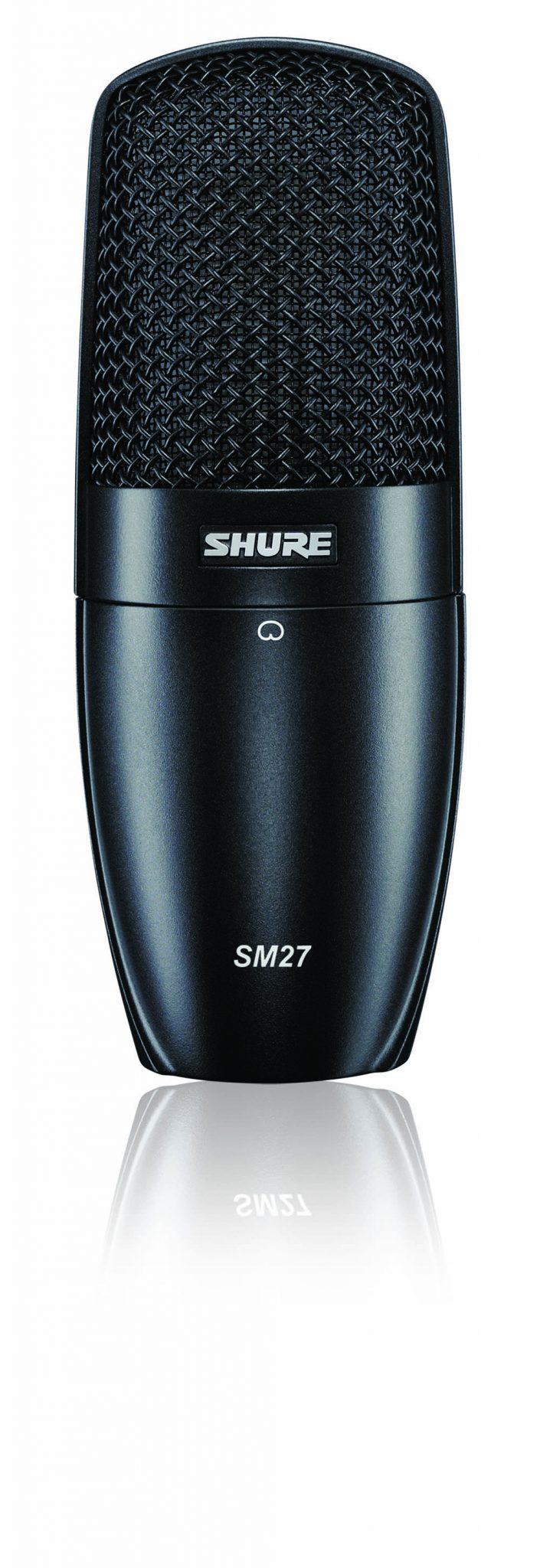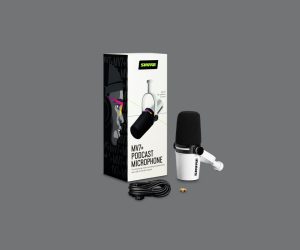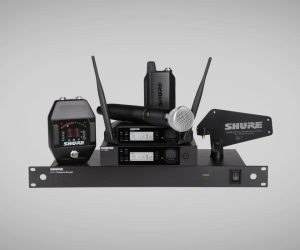
SHURE SM27

A large-diaphragm condenser for live vocals that doesn’t feed back as soon as you looks at it? Surely not!
Text: Mark Woods
Large-diaphragm condenser (LDC) mics have long been favoured by studio engineers for their big, rich sound, particularly on vocals, but they’ve never been that popular in the world of live sound. They’re used in some acoustic styles like bluegrass and classical music but they’re generally considered too big, too delicate, too expensive, too hard to use without a pop-shield and too prone to feedback for rock.
Over the last few years this has been changing along with the broader availability of reasonably priced and quite robust LDCs, although rather than being used for vocals, in the live domain the most popular applications have been guitar and bass cabs, brass, woodwinds and drum overheads. The world’s leading live microphone manufacturer, Shure, is aiming to remove any limits to the applications of LDCs in live sound by adding the new SM27 to its workhorse SM series.
The Shure SM27 is a side-address LDC that’s evolved out of the discontinued entry-level KSM27 cardioid condenser (from the studio-focused KSM series). It offers improved sound quality and new looks that are more suited to stage use, and has been designed as a true general-purpose mic that can be used on anything from instruments to vocals to drums. So, the question is: does it work live? And the simple answer is: yes!
THE DARK HORSE
Supplied in a well-padded protective soft case the SM27 looks purposeful rather than flashy, and its dark-grey finish and unobtrusive right-angled mount allows it to blend in rather than stand out on stage. The pickup pattern is cardioid-only and on the back there are switches for a 15dB pad and two LF roll-off settings. As well as being functional the switches make it easy to tell the front from the back in low light; I’m sure I’m not the only person to have occasionally set up a side-address mic on a dark stage and ended up with it pointing the wrong way.
The steel grille feels strong and incorporates three mesh layers to reduce plosives and wind noise. The engine inside the SM27 is a one-inch externally biased Mylar diaphragm that feeds a Class-A transformerless preamp. Internal and external connectors are gold plated and a sub-sonic filter reduces mechanical vibration. The self-noise specification has been improved from 14dB for the KSM27 to a very quiet 9.5dB. The 20Hz – 20kHz frequency plot looks flat across the midrange with a small, wide bump at 50Hz and an uneven rise from around 3kHz reaching a peak of +4dB at 7kHz. Max SPL is quoted at 133dB (before the pad) and combined with the lower self-noise figures the dynamic range has increased from 80dB for the KSM27 to 84.5dB for the SM27.
GETTING TO KNOW YOU
I first got to know the SM27 as a recording mic and found it to be easy to use with a warm and appealing quality. Straight out of the box I used it for every instrument on a layered percussion track and once the pad was engaged it had no trouble dealing with the high-level peaks. The high-frequency range produced accurate transients and detail without the hyped exaggeration of some of my other mics. The mids were smooth and rendered good body to the skin drums and the lows went all the way down to the floor, more than adequately representing the deepest instruments.
On a vocal overdub session the SM27’s focused directionality was quite noticeable. The pad was not needed and the output level was about 10dB higher than your average dynamic mic. It seemed to add some emphasis to the low-mids of a male vocal and lacked the high-end airiness of my other LDCs but the customer liked it and the vocal sat happily in the track without any EQ. The two-position HPF is well calibrated: the first position acting from 80Hz with a slope of 18dB per-octave, effectively removing unwanted subsonics; and the second position acting on a much gentler 6dB per-octave slope from 115Hz, specifically to counteract proximity effect. Recording band rhythm tracks gave me a chance to use it on guitar cabinets and here it was right at home producing a big, fat sound in the low-mids with good speaker detail and no undue harshness in the high-mids.
LIVE: FEELING SPECIAL
There’s nothing like a live show though for really getting to know a live mic, so out it came with me to my next gig. I was expecting to try the SM27 on guitar cabs or overheads while I got a feel for it but giving it a test through the foldback quickly made me realise this was a very capable live vocal mic. In some ways it acts like a dynamic mic; the pickup pattern is tight, you can get right on the grille without distortion or plosives, handling noise is well controlled and there’s plenty of gain before feedback. I set it up on a stand beside a Shure Beta58 and was pleasantly surprised to find that in terms of sheer volume it would go within a few dB of the Beta58 but with a much more engaging overall sound. Opening for the Wagons was long-time Melbourne performer Dave Graney. At soundcheck I offered both the Beta58 and the SM27 to Dave and he tried a song through each. He chose the SM27 with the explanation that it made him “feel more special” so I used it during his set and enjoyed every minute of it. It looked impressive, although it’s larger than normal vocal mics and hid some of his face, but the sound was the thing: big in the low-mids, clear with no harshness or stridency across the mids and high-mids, minimal plosives and easy volume. The vocal always seemed to be in the right spot and it seemed to reduce the need to ride the fader to follow loud and soft sections. The only slight negative was a tendency to emphasise sibilance but this was compensated for by the overall richness of the sound.
I was hooked and wanted to keep using it on vocals but Henry Wagons needed to take the mic off the stand as part of his performance so for the headline act I went back to the Beta58. The SM27 probably would have worked on his lead vocal too but may have looked silly, and even though the mic seems strong I didn’t want it to be at risk of being dropped. For the Wagons set I used it on a guitar cab with predictably pleasing results; its frequency response is well suited to guitar or bass amps and it adds fullness to the sound without biting your head off around 2–4kHz like vocal mics commonly do on guitar cabs. I haven’t seen a good stage trashing at the end of a set for some time but the Wagons were obviously excited about their performance and a good part of the drum kit and the main vocal mic hit the floor at the end of their last song, scattering mics and making me glad the borrowed SM27 wasn’t directly involved.
The next weekend I took the mic to the Lomond Hotel for the launch of a CD by Lauren Lee Williams. I had also recorded the CD and knew Lauren’s voice well. She’s kinda country and kinda bluegrass, and the lyrics have to be clear so her voice needs to sit up front in the mix. But like many female vocalists her tone can get hard sounding in the high-mids on loud sections. It was a tough test with a full room: lots of background noise and a fairly small PA but the SM27 worked a treat. The vocal sat easily in front of the band without chasing the level too much and the mic delivered a smooth professional quality with clear diction. It looked good too and I knew it had made an impression when two female singers from the audience came up to me after the show asking what it was.
My final live test involved noisy bands in a noisy town hall. Not my favourite type of show and not the occasion to appreciate subtle differences between vocal microphones… it was more a case of: ‘Can I hear the vocal at all over this racket?’. So I used the SM27 as the kick mic instead and was again pleased with how well it worked. It needed the 15dB pad and some cut in the low-mids, as kick mics often do, but produced a good deep thump with a fat quality that reminded me of the old AKG D12. I don’t like clicky kicks much and for me there was just enough brightness to hear the attack of the beater. I suspect some sound mixers might find it too thick without a fair amount of added mid/high EQ.
AN IMPRESSIVE NEWCOMER
The Shure SM27 is a great addition to the SM series and its ability to be used up close as a live vocal mic without needing a pop-shield is its strongest attribute. It won’t replace hand-held mics for singers who take the mic off the stand but for many singers it will look and sound better than dynamic vocal mics, particularly where sensitivity and nuance is more important than bite. It’s a genuine all-rounder that will do a great job on instruments, particularly ones that the SM58/57s don’t do so well. It’s also a very capable general-purpose recording mic at a price that’s well suited to project studios and home recording setups. I want one.
















RESPONSES